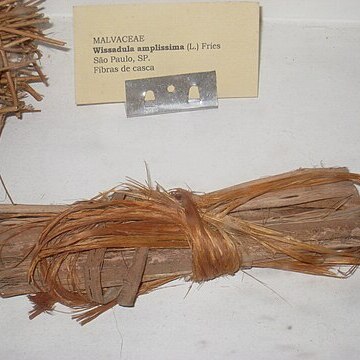Herbs or subshrubs, annual or perennial, usually erect, stellate hairy or sometimes glabrate, sometimes with long simple hairs. Leaves simple; leaf blade ovate to narrowly triangular, without foliar nectaries, base cordate, margin entire or crenate-dentate, apex acuminate. Flowers axillary or subterminal, usually grouped into terminal panicles. Pedicels articulate. Epicalyx absent. Calyx shallowly cup-shaped to campanulate, lobes 5, longer than tube. Corolla yellow, cream, or white, small, ± rotate; petals 5, connate at base, adnate to filament tube. Filament tube shorter than free portions of filaments; anthers all terminal, not exserted. Ovary 3-5-loculed; ovules 3 per locule, usually erect; style arms as many as locules, filiform, longer than filaments; stigmas capitate. Fruit a schizocarp but septicidal dehiscence often incomplete (i.e., pseudocapsular), obconical; mericarps 3-5, eventually dehiscent, transversely divided by an internal septum into an indehiscent proximal cell and a dehiscent terminal cell, apex beaked. Seeds 1-3 per mericarp, 1 in proximal cell and usually 2 in distal cell, pubescent (seed in proximal cell more densely so).
Subshrubs [perennial herbs]. Stems usually erect, hairy [glabrate], not viscid. Leaves distalmost sometimes subsessile; stipules usually persistent, filiform, subulate, or minute; blade broadly ovate to ovate-triangular [narrowly triangular], unlobed, base cordate, margins entire [crenate-dentate], surfaces usually stellate-hairy [sometimes glabrate]. Inflorescences terminal panicles or racemes; involucel absent. Flowers: calyx not accrescent, not inflated, shorter than mature fruits, lobes not ribbed, triangular; corolla usually yellowish, sometimes white, rotate; staminal column exserted; style 3–6-branched; stigmas capitate. Fruits schizocarps, erect, not inflated, obovoid, not indurate; mericarps 3–6, 2-celled, apex bulbous-apiculate, proximal cell indehiscent, distal cell dehiscent. Seeds (1–)3 per mericarp, lower cell 1-seeded, upper cell usually 2-seeded, hairy, proximal seed relatively more densely hairy. x = 7.
Fruit of 3–5 free mericarps transversely divided by an internal false dissepiment formed by an oblique constriction of the lateral walls, beaked, pubescent, and ultimately septicidal, the anterior portion sometimes also loculicidal.
Seeds 1–3 per mericarp, subglobose-reniform, pubescent; cotyledons lying one within the other, forming a deeply concave structure.
Ovary of 3–5, (1) 2–3-ovulate, free carpels; style short, with 3–5 long terete branches; stigmas capitate.
Calyx 5-cleft, stellate-hairy, shallowly saucer-shaped; the lobes longer than the tube, deltoid-ovate.
Leaves usually cordate at the base, acuminate, petiolate, entire or denticulate; stipules setaceous.
Staminal tube very short, ventricose; free parts of filaments numerous, slender, elongate, linear.
Flowers orange, yellow or cream, in a lax panicle.
Petals obovate or obovate-spathulate.
Small erect shrubs or suffrutices.
Epicalyx absent.

